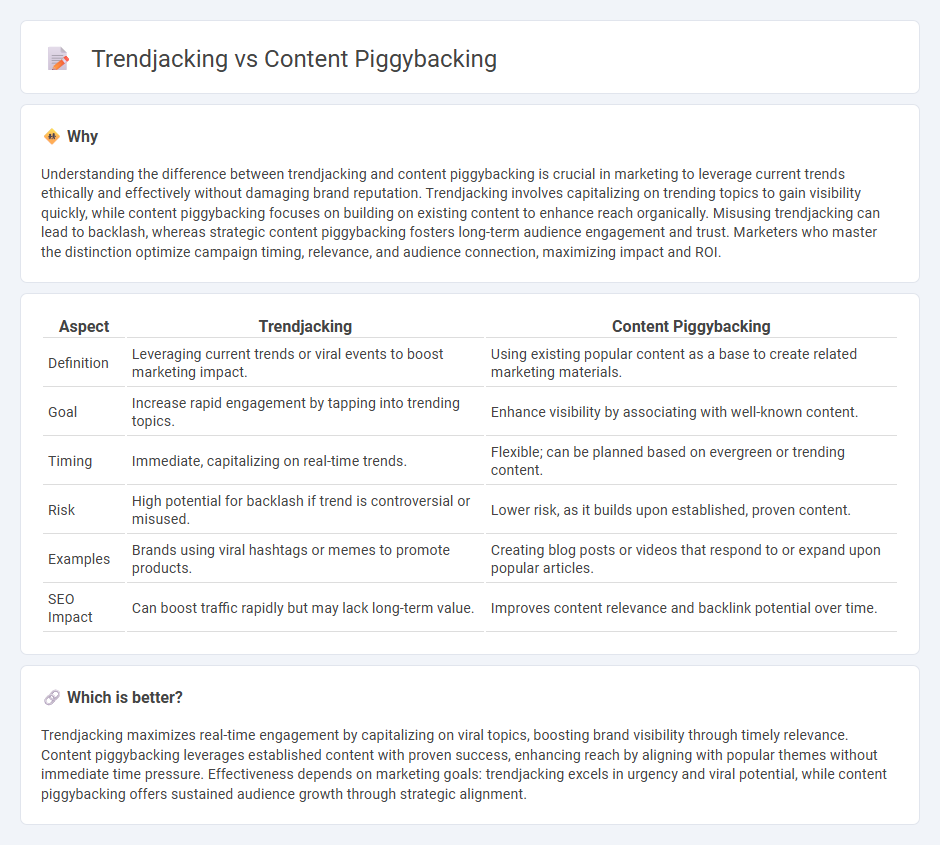
Trendjacking leverages current viral trends to instantly boost brand visibility by aligning marketing messages with popular topics, while content piggybacking involves building on existing high-performing content to attract a targeted audience. Both strategies harness the momentum of external content to amplify reach and engagement without creating original viral content from scratch. Explore how these dynamic marketing tactics can transform your campaign effectiveness.
Why it is important
Understanding the difference between trendjacking and content piggybacking is crucial in marketing to leverage current trends ethically and effectively without damaging brand reputation. Trendjacking involves capitalizing on trending topics to gain visibility quickly, while content piggybacking focuses on building on existing content to enhance reach organically. Misusing trendjacking can lead to backlash, whereas strategic content piggybacking fosters long-term audience engagement and trust. Marketers who master the distinction optimize campaign timing, relevance, and audience connection, maximizing impact and ROI.
Comparison Table
| Aspect | Trendjacking | Content Piggybacking |
|---|---|---|
| Definition | Leveraging current trends or viral events to boost marketing impact. | Using existing popular content as a base to create related marketing materials. |
| Goal | Increase rapid engagement by tapping into trending topics. | Enhance visibility by associating with well-known content. |
| Timing | Immediate, capitalizing on real-time trends. | Flexible; can be planned based on evergreen or trending content. |
| Risk | High potential for backlash if trend is controversial or misused. | Lower risk, as it builds upon established, proven content. |
| Examples | Brands using viral hashtags or memes to promote products. | Creating blog posts or videos that respond to or expand upon popular articles. |
| SEO Impact | Can boost traffic rapidly but may lack long-term value. | Improves content relevance and backlink potential over time. |
Which is better?
Trendjacking maximizes real-time engagement by capitalizing on viral topics, boosting brand visibility through timely relevance. Content piggybacking leverages established content with proven success, enhancing reach by aligning with popular themes without immediate time pressure. Effectiveness depends on marketing goals: trendjacking excels in urgency and viral potential, while content piggybacking offers sustained audience growth through strategic alignment.
Connection
Trendjacking leverages current trending topics to amplify brand visibility by aligning marketing content with popular conversations, while content piggybacking involves embedding marketing messages within existing high-engagement content to boost reach. Both strategies capitalize on the momentum of viral or widely consumed media to increase audience engagement and drive traffic efficiently. Integrating trendjacking and piggybacking enhances marketing campaigns by tapping into established interest patterns and maximizing content relevance.
Key Terms
Virality
Content piggybacking leverages existing popular content to boost visibility by aligning new material with well-established themes, enhancing organic reach through audience familiarity. Trendjacking involves capitalizing on real-time trending topics or viral events to create timely, highly shareable content that can rapidly increase brand exposure. Explore more insights on maximizing virality through strategic content tactics.
Timeliness
Content piggybacking leverages existing popular topics by aligning related content to enhance relevance and audience engagement without necessarily being time-sensitive. Trendjacking capitalizes on emerging trends and viral moments, emphasizing rapid response and timeliness to maximize visibility and impact. Explore the nuances between these strategies to optimize your content marketing efforts effectively.
Relevance
Content piggybacking involves leveraging existing popular topics without altering the original context, ensuring the message aligns seamlessly with the audience's interests and brand values. Trendjacking capitalizes on viral trends by inserting a brand's take into the ongoing conversation, aiming for timely relevance but risking misalignment if not carefully executed. Explore how mastering relevance in these strategies can enhance your brand's engagement and authenticity.
Source and External Links
Content Piggybacking - Ranktracker - Content piggybacking is a digital marketing technique where content is created to align with or respond to trending topics, popular events, or high-performing content, leveraging existing buzz to increase visibility and engagement.
The Piggyback Technique For Getting More Sales - Ian Brodie - This approach involves attaching sales messages to valuable content like emails or videos, delivering useful information first to lower barriers before presenting a sales offer.
What is piggybacking in marketing? - Clym - Piggyback marketing is a cost-effective strategy where companies promote each other's complementary products or share digital content to expand reach and increase brand awareness.
 dowidth.com
dowidth.com